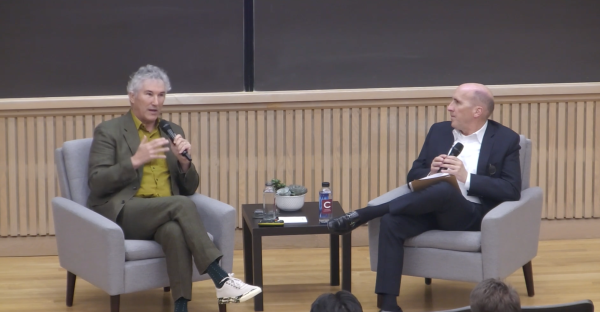Study Spaces May Be Crunched By Library Construction
As Case Library Construction becomes more visible (and audible) around campus, uncertainty has circulated regarding the construction’s impact on student study space. Much of this uncertainty comes from the architect change, from Pickard Chilton Architects to Shepley Bulfinch Richardson and Abbott and Tai Soo Kim, and the fact that interior designs of the library have not been finalized. Senior Student Government Association representative Kevin McAvey said, “With the second architect, as we make the transition, there is probably going to be a delay of 90 days or so,” McAvey said. “What they are looking for right now is to keep the library open for next semester in its entirety.”Frank Gavett, Head of Access Services and Projects for Case Library, agreed. “There will be no changes until after finals spring semester, through the end of this academic year,” he said. Though McAvey predicted that the library will shut down entirely in the fall of 2005, Gavett explained that a final decision had not been made about maintaining occupancy of the building. He weighs both options.”If we stay in the building, we will be limited to half of one floor for everything that we do,” he said. “The only thing we would keep in the building as far as student study space would be some computing space and the space that’s necessary to support reference and a small amount of additional seating for a total of 100 seats.”Gavett explained that they have been looking more seriously at the other option, the one McAvey predicted.”We have started thinking more seriously about moving out of the building for a number of reasons,” Gavett said. “One is that we’ve had some experience with the kind of disruption that construction causes in an occupied building. You can hear it now. And it’s only going to get worse.”Disruptions would obviously adversely affect students. “We want to provide a high quality space for students and that’s going to get very difficult in this building,” he said. Moving out of the building would be advantageous from another perspective. “From the construction point of view, it’s a lot cheaper to work on a building that’s not occupied,” he said. “[Construction crews] can get it done faster, with less worry about.”McAvey also noted the benefits of moving out of the building. He said, “It would enable the construction to go at a quicker pace, it would save a lot of money, and it would enable students to get back to the library that much quicker.”Though the occupation decision has not yet been made, plans to accommodate the need for student study space are already being set in motion. “One thing that we do know is that we are going to take over James C. Colgate Hall [the Student Union],” he said. “We’ve done some preliminary plans for the Hall of Presidents; we expect to get about 200 seats in there. We’ll be taking over the Pub; it will be functioning as a caf?e/study area.”Use of campus dining halls is also being considered. Gavett said, “We don’t know exactly what we’re going to do with them, but it’s very likely that they’ll be part of the mix. McAvey also mentioned the use of the University Apartment’s Commons to help make up for lack of library study space. “SGA has come forward with a plan to turn the Commons into a fantastic study space that could be utilized by juniors and seniors who are living in the apartments,” he said. “That will provide some relief.”Along with the changes in study space, there will also be some changes in what resources students can use. Students will be able to use about 250,000 volumes that the library staff plans to load into a laser system over spring break. Students will also retain access to other resources, including 20% of the bound periodical collection, the entire reference collection, the 2,400 paper titles, all of the periodicals on microfilm, plus the 17,000 titles that students can still access electronically.Much of this information may still seem unclear, which is why McAvey urged those with questions about library construction to bring them to their senator and they will be dealt with on Tuesday.This presentation represents one of the many ways students are involved in this process. Both McAvey and Gavett emphasized the importance of student voice in the library construction project. McAvey said, “It should be assured that students are being represented and our voices are being heard, and a lot of people are bending over backward to accommodate.”McAvey stressed how positive the new library will be. He said, “This is a good thing for everyone. Long-term the university will be 10 times better with this fantastic building.”Regardless of the decisions about staying in the library or moving out or how long the actual construction will take, student study space is top of the priority list. “There will definitely be as many study spaces available to students next fall as there are here,” Gavett said. “They just won’t be in the same place.”




